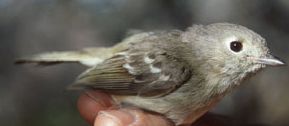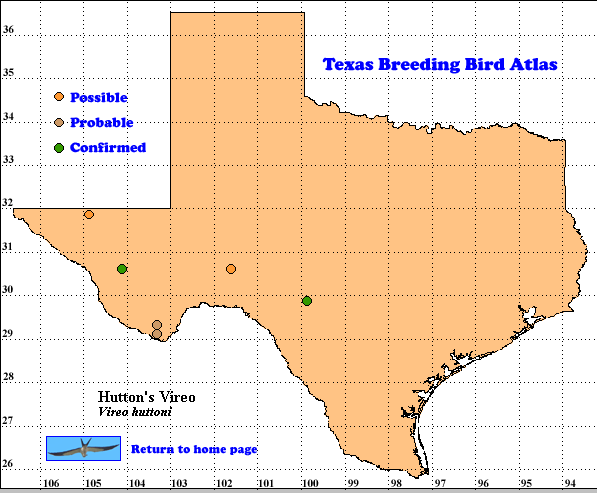Hutton’s Vireo is a complex of 7 subspecies, many with allopatric (non-contiguous) ranges. The subspecies on the Pacific Coast and the one in western Mexico and Arizona differ genetically and in vocalization (Johnson et al. 1988, Baril 2000). Other subspecies have not been studied as extensively. Most data on Hutton’s Vireo is from the Pacific Coast subspecies and may or may not apply to Texas birds (Davis 1995).
DISTRIBUTION. During the 1987-1992 TBBA field work volunteers found confirmed breeding evidence for Hutton’s Vireo in the Davis Mountains and the Edwards Plateau with probable breeding in the Guadalupe Mountains, Big Bend National Park and near the Pecos River.
In other areas Hutton’s Vireo is resident from Vancouver Island, British Columbia south along the Pacific Coast and in the foothills of the Sierra Nevada Mountains of California to northern Baja California. An isolated population occurs near the tip of Baja California Sur. Resident populations extend at middle elevations south from Arizona and Texas on the wooded western and eastern slopes of mainland Mexico to the Isthmus of Tehuantepec. Isolated subspecies also ooccur along the coast of Oaxaca and in the highlands of Chiapas, Mexico and Guatemala (Davis 1995, Howell and Webb 1995).
SEASONAL OCCURRENCE. The species is a year-round resident of its breeding range (Oberholser 1974, Davis 1995).
BREEDING HABITAT. Oberholser (1974) describes the preferred habitat of Hutton’s Vireo in Texas as pinyon, juniper and oak woodlands in the arid foothills. In Mexico Howell and Webb found the species in pine-oak habitat while in Arizona Corman (2005) reports 35% of breeding is in evergreen oak, juniper and pinyon, and nearly 20% is in riparian woodlands.
Hutton’s Vireos in Arizona commonly place their nests 2-7.5 m (7-25 ft) above ground. Both sexes build the deep, hanging cup, anchored to horizontal twigs. The nest is built of moss, plant fiber, spider cocoons, held together with spider silk and lined with fine grasses and occasionally hair. The outside diameter is 7.5 cm (3 in), height 7 cm (2.7 in), inside diameter 6 cm (2.4 in) and cup depth 4.5 cm (1.8 in). The nest looked from below like a white ball hanging.
The female usually lays 4 (range 3-5) smooth, dull, white eggs which both sexes incubate for 16 days and young birds depart the nest about 14 days after hatching. The species is an uncommon host to brood parasites. Pairs may raise 2 broods per year (Harrison 1979, Davis 1995).
STATUS. Lockwood and Freeman 2004) rate the species as a locally common summer and uncommon winter resident in the Trans-Pecos mountains. The North American Breeding Bird Survey does not sample this species in Texas so no population trend estimate is available (Sauer et al. 2005).
The additional records from the Edwards Plateau in an area where Oberholser (1974) did not report breeding, suggest a range expansion (Lockwood and Freeman 2004). This possibility is encouraging for the status of Hutton’s Vireo in Texas.
Text by Robert C. Tweit (2006)
Literature cited.
Baril, C. T. 2000. Pacific coast and southwest interior populations of Hutton,s Vireo differ in basic song parameters. Condor 102: 911-914.
Corman, T. E. 2005. Hutton’s Vireo (Vireo huttoni). In Arizona breeding bird atlas. pp. 344-345 (T. E. Corman and C. Wise-Gervais, eds.). University of New Mexico Press, Albuquerque.
Davis, J. N. 1995. Hutton’s Vireo (Vireo huttoni). In The birds of North America, No. 189 (A. Poole and F. Gill, eds.). The Birds of North America, Inc., Philadelphia, PA.
Harrison, H. H. 1979. A field guide to western birds’ nests. Houghton Mifflin, Boston, MA.
Howell, S. N. G. and S. Web.b 1995. A guide to the birds of Mexico and northern Central America. Oxford University Press, New York.
Johnson, N. K., R. M. Zink and J. A. Marten. 1988. Genetic evidence for relationships in the avian family Vireonidae. Condor 90: 428-445.
Lockwood, M. W. and B. Freeman. 2004. The TOS handbook of Texas birds. Texas A&M University Press, College Station.
Oberholser, H. C. 1974. The bird life of Texas. University of Texas Press, Austin.
Sauer, J. R., J. E. Hines, and J. Fallon. 2005. The North American Breeding Bird Survey, results and analysis 1966-2004. Version 2005.1. USGS Patuxent Wildlife Research Center, Laurel MD (Web site, http://www.mbr-pwrc.usgs.gov/bbs).

